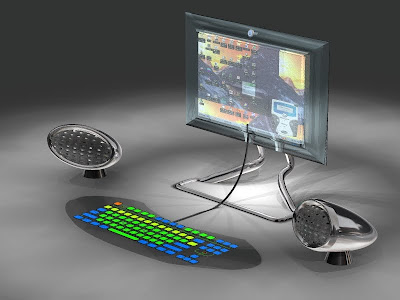
COMPUTER BASIC
Introduction of your new Computer
This tutorial will guide beginning users on how to use their new Dell Computer, and give the specifications on it.
PC Specifications
Name Dell OptiPlex GX260
Processor Intel Pentium 4 2.53GHz
Memory 512MB DDR
Hard Drive 20GB EIDE Hard Drive
Monitor 15" (13.8" viewable) E551
CD-ROM Drive 32X DVD-CDRW Combo
Floppy Drive 3.5, 1.44 MB Floppy Drive
Operating System Windows XP Professional
Mouse Logitech USB 2-Button Optical Mouse
Main Keywords Associated With Microsoft Windows
• Drives :
Drives are devices used to store data. Most computers have at least two drives: a hard drive C:\ (Which is the main means of storage) and a floppy drive (which stores smaller volumes of data (1.44 Mb) on 3.5" disks - floppy disks). The hard drive is typically designated the C:\ drive and the floppy drive is typically designated the A:\ drive. If you have an additional floppy drive, it is typically designated the B:\ drive. You will also have network drives on your computer, depending on authorization and rights of each user. This drives will typically be labeled F:\ or H:\ or G:\
• Folders :
Folders are used to organize the data stored on your drives. Think of your drives as filing cabinets. You want to sort your filing cabinets with folders that store different files. The files that make up a program are stored together in their own set of folders. You will want to organize the files you create in folders. You will probably want to store files of a like kind in a single folder.
• Directory:
A Directory is the path given to a folder on a drive. For example a text file called Phone Numbers is located in the My Documents directory on the C:\ drive. It would therefore read "C:\My Documents\PhoneNumbers.txt"
• File Extensions:
File Extensions are the ending letters associated with a file and an application that it can be manipulated in. This way Windows knows to tell which program to open the file you want to manipulate. For example a text file has an extension of .txt, so a text file created in Notepad called Phone Numbers would look like this PhoneNumbers.txt ... You do not have to assign a file extension to a file that you create. The program you use will automatically do this for you. All you need to do is give it a filename. Some other common extensions are as follows:
doc = Microsoft Word Document
- xls = Microsoft Excel Document
- ppt = Microsoft PowerPoint Presentation
- mdb = Microsoft Access Database
- bmp = Windows Bitmap Picture
- wav = Sound File
- html or .htm = Internet Document
An Icon is a graphic image. Icons help you execute commands quickly. Commands tell the computer what you want the computer to do. To execute a command by using an icon, double-click on the icon.
Turning On Your Computer
1. On the front of your computer, you should see two buttons. The power button is the top one with a whole in the middle of it. The bottom button is a reset button.
2. Press the button
Shutting Down Your Computer
1. Click on the Start at bottom left corner of screen
2. Click on Shutdown (A Shut Down Windows dialog box will appear)
3. Click on Shut Down
4. Click on OK
Restarting Your Computer
(To shutdown and immediately restart your computer)
1. Click on the Start at bottom left corner of screen
2. Click on Shutdown (A Shut Down Windows dialog box will appear)
3. Click on Restart
4. Click on OK
Using Your Mouse
• There are two buttons on each mouse. Whereas on an Apple Computer, there was only one.
• The left mouse button is used to open programs and to select items
• The right mouse button is used to open a sub menu to get other options
Accessing Your Network Drive
• Once you log in with your UserID and Password, you will have your own "home" drive to store your files on. In the past, you saved your information and files on the C:\ Drive (Hard Drive). Now you will save your information on your "home" drive. This allows you to log onto any computer connected to the network and still have access to your files.
Finding Files On Your Computer
• If, for some reason, you cannot locate a file on your computer or home drive, you still might be able to locate it by using the Find Files Program.
1. Click on the Start at bottom left corner of screen
2. Click on Find
3. Select the Find Files or Folders
4. Enter your search criteria. You do not need to complete every field. Only enter the criteria you want to use for your search. Switch through the different tabs (Date, Advanced, Name & Location) to further your search
5. Click the Find Now button
Locating Your Most Recent Files
• Windows provides shortcuts to your most recent files, so you may get access to them very quickly.
1. Click on the Start at bottom left corner of screen
2. Click on Documents
3. Select the file that you want
• Copying a file/folder to a floppy disk
1. Select the Folder you want to move or copy
2. Right click on the file or folder in the right pane
3. Select Send To -->
4. Select 3.5 Floppy (A)
5. You can also drag the file to 3.5" Floppy (A:\) in the left pane
• Copying a file/folder from a floppy disk to other drive
1. Select 3.5 Floppy (A:) in the left pane
2. Select the File/Folder you want to copy from in the floppy drive
3. Drag it to your destination
• Renaming A File or Folder
1. Select the File or Folder you want to rename
2. Right Click on it
3. Select Rename
4. Rename File

No comments:
Post a Comment